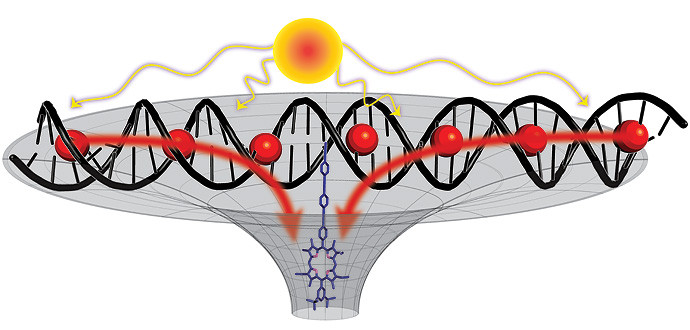Researchers at Chalmers University of Technology have found an effective solution for collecting sunlight for artificial photosynthesis. By combining self-assembling DNA molecules with simple dye molecules, the researchers have created a system that resembles nature’s own antenna system.
Artificial photosynthesis is one of the hot trends in energy research. A large number of the worlds’ energy problems could be resolved if it were possible to recreate the ability plants have to transform solar energy into fuel. The Earth receives enough solar energy every hour to satisfy our energy needs for an entire year.
A research team at Chalmers University of Technology has made a nanotechnological breakthrough in the first step required for artificial photosynthesis. The team has demonstrated that it is possible to use self-assembling DNA molecules as scaffolding to create artificial systems that collect light. The results were recently published in the esteemed scientific Journal of the American Chemical Society.
Self-assembling system
Scaffolding in plants and algae consists of a large number of proteins that organise chlorophyll molecules to ensure effective light collection. The system is complicated and would basically be impossible to construct artificially.
“It’s all over if a bond breaks,” says Jonas Hannestad, PhD of physical chemistry. “If DNA is used instead to organise the light-collecting molecules, the same precision is not achieved but a dynamic self-constructing system arises.”
Recreates a part of nature’s miracle
With a system that builds itself, the researchers have begun to approach nature’s method. If any of the light-collecting molecules break, it will be replaced with another one a second later. In this sense, it is a self-repairing system as opposed to if molecules had been put there by researchers with synthetic organic chemistry.
The sun’s light is moved to a reaction centre in plants and algae so they can synthesise sugars and other energy-rich molecules.
“We can move energy to a reaction centre, but we have not resolved how the reactions themselves are to take place there,” says Bo Albinsson, professor of physical chemistry and head of the research team. “This is actually the most difficult part of artificial photosynthesis. We have demonstrated that an antenna can easily be built. We have recreated that part of the miracle.”
Like pieces in an intricate puzzle
The Chalmers researchers are combining artificial photosynthesis with DNA nanotechnology. When constructing nano-objects that are billionths of a metre, DNA molecules have proven to function very well as building material. This is because DNA strands have the ability to attach to each other in a predictable manner. As long as the correct assembly instructions are given from the start, DNA strands in a test tube can bend around each other and basically form any structure.
“It’s like a puzzle where the pieces only fit together in one specific way,” says Bo Albinsson. “That is why it is possible to draw a fairly complex structure on paper and then know basically what it will look like. We subsequently use those traits to control how light collection will take place.
Story Source:
The above story is reprinted from materials provided by Chalmers University of Technology.





